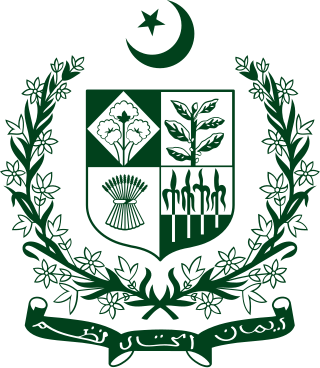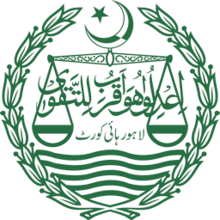Related Research Articles

The Politics of Pakistan takes place within the framework established by the constitution. The country is a federal parliamentary republic in which provincial governments enjoy a high degree of autonomy and residuary powers. Executive power is vested with the national cabinet which is headed by Prime Minister of Pakistan, who works with the bicameral parliament and the judiciary. Stipulations set by the constitution provide a delicate check and balance of sharing powers between executive, legislative, and judicial branches of the government.
"Prerogative writ" is a historic term for a writ that directs the behavior of another arm of government, such as an agency, official, or other court. It was originally available only to the Crown under English law, and reflected the discretionary prerogative and extraordinary power of the monarch. The term may be considered antiquated, and the traditional six comprising writs are often called the extraordinary writs and described as extraordinary remedies.

The Supreme Court of Pakistan is the apex court in the judicial hierarchy of the Islamic Republic of Pakistan.
The Federal Court of Canada, which succeeded the Exchequer Court of Canada in 1971, was a national court of Canada that had limited jurisdiction to hear certain types of disputes arising under the federal government's legislative jurisdiction. Originally composed of two divisions, the Appellate Division and the Trial Division, in 2003 the Court was split into two separate Courts, the Federal Court and the Federal Court of Appeal. The court used facilities as the Supreme Court of Canada Building as well as Thomas D'Arcy McGee Building and registry office at 90 Elgin Street.
The court system of Canada is made up of many courts differing in levels of legal superiority and separated by jurisdiction. In the courts, the judiciary interpret and apply the law of Canada. Some of the courts are federal in nature, while others are provincial or territorial.

The Supreme Court (Filipino: Kataas-taasang Hukuman; colloquially referred to as the Korte Suprema, is the highest court in the Philippines. The Supreme Court was established by the Second Philippine Commission on June 11, 1901 through the enactment of its Act No. 136, an Act which abolished the Real Audiencia de Manila, the predecessor of the Supreme Court.
The High Court of Delhi was established on 31 October 1966, through the Delhi High Court Act, 1966. It is the highest court performing judicial functions in the NCT of Delhi at the State level. Below it are the Subordinate Courts, functioning for 11 Judicial Districts namely (1) Central (2) New Delhi (3) South (4) South-West (5) North (6) North-West (7) West (8) North-East (9) East (10)South-East (11)Shahdra It gets its powers from Chapter V in Part VI of the Constitution of India.

The Supreme Court of Oklahoma is a court of appeal for non-criminal cases, one of the two highest judicial bodies in the U.S. state of Oklahoma, and leads the judiciary of Oklahoma, the judicial branch of the government of Oklahoma.

The Lahore High Court is a provincial court house based in Lahore, Punjab, Pakistan. It was established as a high court on 21 March 1882. The Lahore High Court has jurisdiction over the province of Punjab. The High Court's principal seat is in Lahore, but there are benches in three other cities of the province: Rawalpindi, Multan and Bahawalpur.
A master is a judge of limited jurisdiction in the superior courts of England and Wales and in numerous other jurisdictions based on the common law tradition. A master's jurisdiction is generally confined to civil proceedings and is a subset of that of a superior court judge or justice. Masters are typically involved in hearing specialized types of trials, case management, and in some jurisdictions dispute resolution or adjudication of specific issues referred by judges.

In most legal jurisdictions, a supreme court, also known as a court of last resort, apex court, and highcourt of appeal, and court of final appeal, is the highest court within the hierarchy of courts. Broadly speaking, the decisions of a supreme court are binding on all other courts in a nation and are not subject to further review by any other court. Supreme courts typically function primarily as appellate courts, hearing appeals from decisions of lower trial courts, or from intermediate-level appellate courts. A supreme court can also, in certain circumstances, act as a court of original jurisdiction.

The judiciary of Pakistan is the national system of courts that maintains the law and order in the Islamic Republic of Pakistan. Pakistan uses a common law system, which was introduced during the colonial era, influenced by local medieval judicial systems based on religious and cultural practices. The Constitution of Pakistan lays down the fundamentals and working of the Pakistani judiciary.

The High Court Division, Supreme Court of Bangladesh, popularly known as High Court, is one of the two divisions of the Supreme Court of Bangladesh, the other division being the Appellate Division. It consists of the Chief Justice of Bangladesh and the Justices of the High Court Division.

The New Mexico Supreme Court is the highest court in the U.S. state of New Mexico. It is established and its powers defined by Article VI of the New Mexico Constitution. It is primarily an appellate court which reviews civil and criminal decisions of New Mexico's trial courts of general jurisdiction and certain specialized legislative courts, only having original jurisdiction in a limited number of actions. It currently resides in the New Mexico Supreme Court Building in Santa Fe.
The Fifth Amendment to the Constitution of Pakistan was adopted on 5 September 1976, by the elected Parliament of Pakistan under the democratic government of Zulfikar Ali Bhutto.
The Supreme Court of the Northwest Territories is the name of two different superior courts for the Canadian territory of the Northwest Territories, which have existed at different times.

The judicial officers of the Republic of Singapore work in the Supreme Court and the State Courts to hear and determine disputes between litigants in civil cases and, in criminal matters, to determine the liability of accused persons and their sentences if they are convicted.

There are five high courts of Pakistan, each based in the capital city of the four provinces, plus one in the federal capital, Islamabad. Articles 192 to 203 of the Constitution of Pakistan outline the constitution of the courts, appointment of the judges, their oath of office, and jurisdiction of the high courts.
The Eighteenth Amendment of the Constitution of Pakistan was passed by the National Assembly of Pakistan on April 8, 2010, removing the power of the President of Pakistan to dissolve the Parliament unilaterally, turning Pakistan from a semi-presidential to a parliamentary republic, and renaming North-West Frontier Province to Khyber Pakhtunkhwa. It also gave self-governing, legislative and financial autonomy to provincial authorities. The package was intended to counter the sweeping powers amassed by the presidency under former presidents General Pervez Musharraf and General Muhammad Zia-ul-Haq and to ease political instability in Pakistan. The bill reversed many infringements on the Constitution of Pakistan over several decades by its military rulers. The amendment bill was passed by the Senate of Pakistan on April 15, 2010 and it became an act of parliament when President Asif Ali Zardari signed the bill on April 19, 2010. It was the first time in Pakistan's history that a president relinquished a significant part of his powers willingly and transferred them to parliament and the office of the prime minister.

The Indian High Courts Act 1861 was an act of the Parliament of the United Kingdom to authorize the Crown to create High Courts in the Indian colony. Queen Victoria created the High Courts in Calcutta, Madras, and Bombay by Letters Patent in 1862. These High Courts would become the precursors to the High Courts in the modern day India, Pakistan, and Bangladesh. The Act was passed after the First War of Independence of 1857 and consolidated the parallel legal systems of the Crown and the East India Company.
References
- ↑ Newspaper, the (June 17, 2020). "From The Past Pages Of Dawn: 1970: Fifty Years Ago: New High Courts". Dawn .